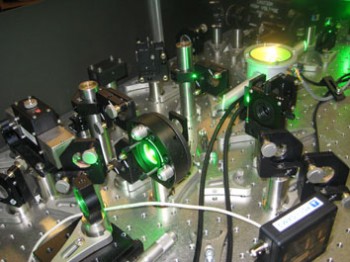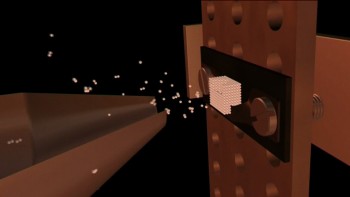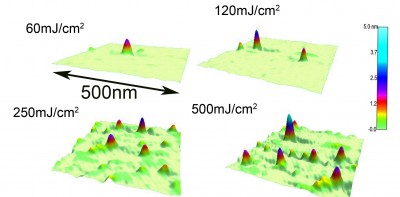Ultrafast Lasers in Physics
(If Flash is installed JavaScript is activated, you can watch a video inside this web page.)
 If you are interested in a (not too serious) explanation of ultra-short laser applications, download this movie (in German. approx. 250MByte, itunes Format mpeg4) Have fun!
If you are interested in a (not too serious) explanation of ultra-short laser applications, download this movie (in German. approx. 250MByte, itunes Format mpeg4) Have fun!
Interaction of matter with ultra-short laser radiation
 Interaction of ultra-short laser pulses with surfaces and solids is of particular interest for surface and material modification, nano-structuring[1-3], laser removal (laser ablation) of material[4-6] and material analysis[7, 8]. It has been shown that femto–second lasers can induce structural modification by nonlinear absorption in transparent materials. This is used to produce optical data storage devices, waveguides, gratings, couplers, power splitters, wavelength conversion devices and optical amplifiers[9, 10].
Laser ablation[11] and laser desorption[12] represent an important class of phenomena resulting from the interaction of laser light with materials. The interaction process leads in this case to the emission of particles and transient or permanent modification of the material topography[13] and/or material properties. Both, the particle emission and the change in material properties can be regarded as a clue to the specific processes resulting from the laser radiation. Particularly for ultra-short laser radiation the details of the mechanisms that lead to ablation remain still a challenge because of the complexity of the processes taking place, the variety of species involved, and the range of length and time scales covered[14]. This is valid as far as atomic-level experimental information is concerned as well as it is the case for the availability of an adequate theory.
Interaction of ultra-short laser pulses with surfaces and solids is of particular interest for surface and material modification, nano-structuring[1-3], laser removal (laser ablation) of material[4-6] and material analysis[7, 8]. It has been shown that femto–second lasers can induce structural modification by nonlinear absorption in transparent materials. This is used to produce optical data storage devices, waveguides, gratings, couplers, power splitters, wavelength conversion devices and optical amplifiers[9, 10].
Laser ablation[11] and laser desorption[12] represent an important class of phenomena resulting from the interaction of laser light with materials. The interaction process leads in this case to the emission of particles and transient or permanent modification of the material topography[13] and/or material properties. Both, the particle emission and the change in material properties can be regarded as a clue to the specific processes resulting from the laser radiation. Particularly for ultra-short laser radiation the details of the mechanisms that lead to ablation remain still a challenge because of the complexity of the processes taking place, the variety of species involved, and the range of length and time scales covered[14]. This is valid as far as atomic-level experimental information is concerned as well as it is the case for the availability of an adequate theory.
Emission of particles during laser ablation
 The initial step of how energy of an ultra short laser pulse is transferred to a solid results in the creation of hot electrons in the conduction band[15]. In the case of dielectrics or semiconductors, in a first step, however, electrons have to be promoted to the conduction band[13]. The creation of hot, fast electrons represents a situation very similar to the one encountered for highly charged ion interaction with surfaces[16].
The energy flow from the excited electrons (thermal, hot, ballistic) to the lattice atoms (ejected or remaining in the solid) is very complex and manifold. Most importantly, we can distinguish between resulting fast electronic and thermal processes. The way (magnitude, timescale etc.) in which the energy is deposited to the electronic system, determines to a large extent, how efficient these different processes contribute. Therefore, a promising approach to identify these processes is to vary the time behavior of the energy deposition (pulse length, pump-probe experiments) an study the corresponding changes in particle emission characteristics[17-20].
It is essential to be able to vary the time (and as a result the amount) of the energy deposited in the electronic system. For ultra short pulses, in principle, two alternatives are feasible: a) changing the pulse length with a pulse-shaping device or b) using a two-pulse autocorrelation setup in which the differential yield of emitted particles is measured as a function of the temporal separation between a pair of ablation pulses with a reflectron-type time-of-flight (TOF) spectrometer. The intensity of each pulse has to be kept below the ablation threshold[17]. Since most of the particles are neutrals, post-ionization of the particles by a laser is a requirement. In addition, the energy of the particles has to be measured.
The initial step of how energy of an ultra short laser pulse is transferred to a solid results in the creation of hot electrons in the conduction band[15]. In the case of dielectrics or semiconductors, in a first step, however, electrons have to be promoted to the conduction band[13]. The creation of hot, fast electrons represents a situation very similar to the one encountered for highly charged ion interaction with surfaces[16].
The energy flow from the excited electrons (thermal, hot, ballistic) to the lattice atoms (ejected or remaining in the solid) is very complex and manifold. Most importantly, we can distinguish between resulting fast electronic and thermal processes. The way (magnitude, timescale etc.) in which the energy is deposited to the electronic system, determines to a large extent, how efficient these different processes contribute. Therefore, a promising approach to identify these processes is to vary the time behavior of the energy deposition (pulse length, pump-probe experiments) an study the corresponding changes in particle emission characteristics[17-20].
It is essential to be able to vary the time (and as a result the amount) of the energy deposited in the electronic system. For ultra short pulses, in principle, two alternatives are feasible: a) changing the pulse length with a pulse-shaping device or b) using a two-pulse autocorrelation setup in which the differential yield of emitted particles is measured as a function of the temporal separation between a pair of ablation pulses with a reflectron-type time-of-flight (TOF) spectrometer. The intensity of each pulse has to be kept below the ablation threshold[17]. Since most of the particles are neutrals, post-ionization of the particles by a laser is a requirement. In addition, the energy of the particles has to be measured.
Surface topography and ablation
 It seems quite evident that e.g. the energy of an emitted particle reflects the process, which led to their emission. We can expect quite different energies for particles ejected by Coulomb repulsion or thermally evaporated atoms. Whether the surface topography after irradiation gives us a clue as to which processes took place during laser-matter interaction is not so obvious. For sure, we can expect a substantially modified surface after heating the surface and ablation of substantial amount of material. An originally flat surface will exhibit a lot of “surface topography” after laser irradiation and resulting melting, evaporation etc. In a typical “violent” thermal process craters, large bumps etc. will be left and might give us a hint on the relevant processes.
However, it is not so obvious, whether we can obtain more detailed information on specific processes like Coulomb explosion, hot electron plasmas etc. Do they leave a specific footprint which helps us to identify such processes? In general, the difficulty (not surprisingly this is also the case for studying the particle emission characteristics) is mainly due to the fact that there is only a relatively small range of laser intensities (close to the ablation threshold), for which different possible processes contribute with a comparable strength to leave distinguishable tracks. At higher laser intensities the thermal footprint left behind is usually overwhelming (e.g. craters and mountains on the surface, thermal energies of particles, typical picosecond timescales for the energy deposition).
For this purpose the formation of nano-hillocks, which has been recently reported for sputtering with highly charged ions[16], represents very valuable information. It reveals a) the creation of a typical nano-sized (few nm diameter and height) localized hillock at the ion impact site and b) a sharp and well defined threshold of potential energy carried into the collision of about 14 keV for hillock formation on CaF2 surfaces. These very specific topographic features can, therefore, be interpreted as characteristic for a large localized potential energy transfer to the electronic system.
It should be stated that both the emission characteristic as well as topographic features represent very valuable information with respect to the physics of the ablation process. In our opinion it is even more helpful with regard to understand the processes, if a correlation between both can be established, in particular if we can associate specific topographic features with particular particle energies etc.
It seems quite evident that e.g. the energy of an emitted particle reflects the process, which led to their emission. We can expect quite different energies for particles ejected by Coulomb repulsion or thermally evaporated atoms. Whether the surface topography after irradiation gives us a clue as to which processes took place during laser-matter interaction is not so obvious. For sure, we can expect a substantially modified surface after heating the surface and ablation of substantial amount of material. An originally flat surface will exhibit a lot of “surface topography” after laser irradiation and resulting melting, evaporation etc. In a typical “violent” thermal process craters, large bumps etc. will be left and might give us a hint on the relevant processes.
However, it is not so obvious, whether we can obtain more detailed information on specific processes like Coulomb explosion, hot electron plasmas etc. Do they leave a specific footprint which helps us to identify such processes? In general, the difficulty (not surprisingly this is also the case for studying the particle emission characteristics) is mainly due to the fact that there is only a relatively small range of laser intensities (close to the ablation threshold), for which different possible processes contribute with a comparable strength to leave distinguishable tracks. At higher laser intensities the thermal footprint left behind is usually overwhelming (e.g. craters and mountains on the surface, thermal energies of particles, typical picosecond timescales for the energy deposition).
For this purpose the formation of nano-hillocks, which has been recently reported for sputtering with highly charged ions[16], represents very valuable information. It reveals a) the creation of a typical nano-sized (few nm diameter and height) localized hillock at the ion impact site and b) a sharp and well defined threshold of potential energy carried into the collision of about 14 keV for hillock formation on CaF2 surfaces. These very specific topographic features can, therefore, be interpreted as characteristic for a large localized potential energy transfer to the electronic system.
It should be stated that both the emission characteristic as well as topographic features represent very valuable information with respect to the physics of the ablation process. In our opinion it is even more helpful with regard to understand the processes, if a correlation between both can be established, in particular if we can associate specific topographic features with particular particle energies etc.
References
[1] B.N. Chichkov, E. Fadeeva, J. Koch, A. Ostendorf, A. Ovsianikov, S. Passinger, C. Reinhardt, Proceedings of SPIE - The International Society for Optical Engineering 6106 (2006).
[2] J. Koch, T. Tanabe, F. Korte, C. Fallnich, A. Ostendorf, B.N. Chichkov, Proceedings of SPIE - The International Society for Optical Engineering 5662 (2004) 743.
[3] F. Korte, J. Koch, S. Nolte, C. Fallnich, B.N. Chichkov, Springer Series in Chemical Physics 71 (2003) 666.
[4] A. Ostendorf, G. Kamlage, U. Klug, F. Korte, B.N. Chichkov, Proceedings of SPIE - The International Society for Optical Engineering 5713 (2005) 1
[5] B.N. Chichkov, F. Korte, J. Koch, S. Nolte, A. Ostendorf, Proceedings of SPIE - The International Society for Optical Engineering 4760/I (2002) 19
[6] W. Kautek, S. Mitterer, J. Kruger, W. Husinsky, G. Grabner, Applied Physics A Solids and Surfaces 58/5 (1994) 513.
[7] R. Hergenroder, O. Samek, V. Hommes, Mass Spectrometry Reviews 25/4 (2006) 551.
[8] O. Samek, A. Kurowski, S. Kittel, S. Kukhlevsky, R. Hergenroder, Spectrochimica Acta Part B-Atomic Spectroscopy 60/7-8 (2005) 1225.
[9] N. Belhadj, Y. Park, S. LaRochelle, K. Dossou, J. Azana, Optics Express 16/12 (2008) 8727.
[10] C.Y. Liu, X.L. Mao, R. Greif, R.E. Russo, Journal of Physics: Conference Series 59/1 (2007) 338.
[11] L.V. Zhigilei, P.B.S. Kodali, B.J. Garrison, Journal of Physical Chemistry B 102/16 (1998) 2845.
[12] M. Henyk, D. Wolfframm, J. Reif, Nuclear Instruments & Methods in Physics Research Section B-Beam Interactions with Materials and Atoms 166 (2000) 716.
[13] D.S. Ivanov, B. Rethfeld, G.M. O'Connor, T.J. Glynn, A.N. Volkov, L.V. Zhigilei, Applied Physics A: Materials Science and Processing (2008) 1.
[14] D. Lewis, D. Perez, Appl. Surf. Sci. (2008).
[15] B. Rethfeld, A. Kaiser, M. Vicanek, G. Simon, Applied Physics A: Materials Science and Processing 69/7 (1999).
[16] A.S. El-Said, R. Heller, W. Meissl, R. Ritter, S. Facsko, C. Lemell, B. Solleder, I.C. Gebeshuber, G. Betz, M. Toulemonde, W. Mo?ller, J. Burgdo?rfer, F. Aumayr, Physical Review Letters 100/23 (2008).
[17] V. Schmidt, W. Husinsky, G. Betz, Physical Review Letters 85/16 (2000) 3516.
[18] V. Schmidt, W. Husinsky, G. Betz, Applied Surface Science 197 (2002) 145.
[19] H. Dachraoui, W. Husinsky, Physical Review Letters 97/10 (2006).
[20] H. Dachraoui, W. Husinsky, Applied Physics Letters 89/10 (2006).
— -Wolfgang Husinsky 2009-03-23 09:44